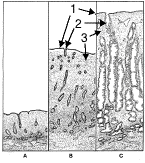Slide DMS179 [Uterus, secretory, human, PTS]. This is a section of the uterus with endometrium in the secretory (luteal) stage of the menstrual cycle (days 14-28). The glands of the stratum functionalis are coiled, irregular in diameter and lined by columnar cells that show signs of secretion. Some secretory products occupy the glandular lumens. The columnar cells lining the glands are larger and taller than their counterparts in the proliferative endometrium. Many of the lining cells bulge into the lumen of the glands and often the cytoplasm of the glandular cells is vacuolated due to contained secretions. The nuclei of these cells are large and appear to contain less heterochromatin than those in the proliferative endometrium. The glands of the stratum basalis are different. They show few, if any signs of secretion, the cells are smaller, the nuclei contain more heterochromatin and the cells are closer together. The stroma of the functionalis is somewhat variable in appearance. In many places the cells are separated by intercellular fluid. Some of the cells are large and vacuolated. These are said to show "deciduoid change" and resemble stromal cells of a pregnant endometrium. There are a few more lymphocytes in the stroma than were present in the proliferative endometrium. There are no obvious mitotic figures, either in the glandular cells or in the stroma.

The uterine mucosa during the menstrual cycle
A. Beginning of proliferative phase
B. End of proliferative phase; beginning of secretory phase
C. End of secretory phase: 1. Epithelium ; 2. Mucous glands; 3. Lamina propria